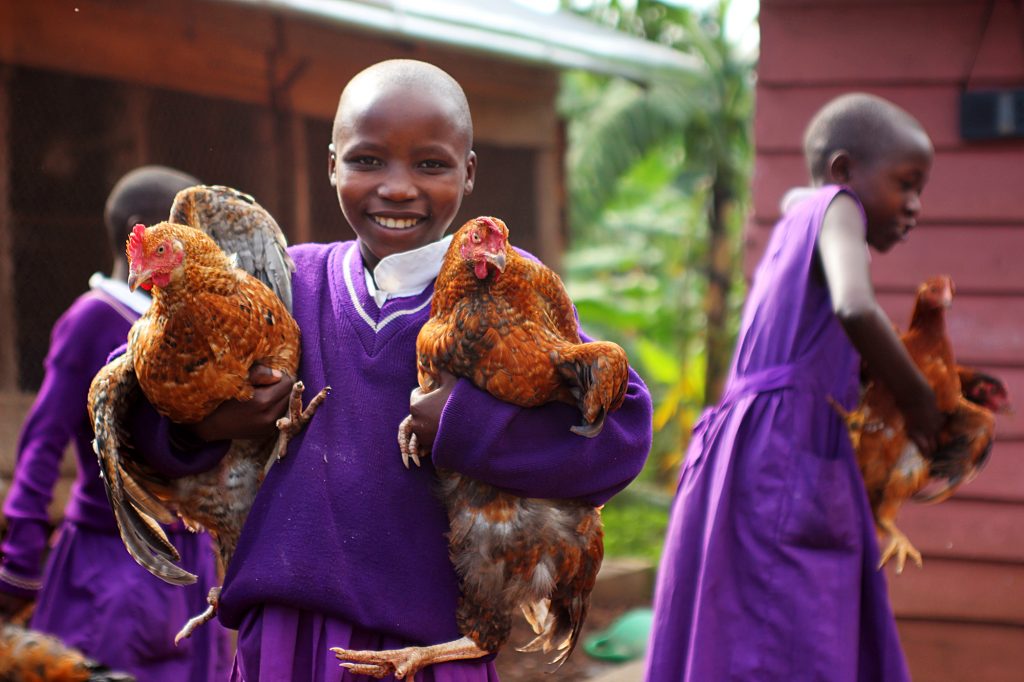GlobalGiving is an organisation that focuses on a bottom-up approach to aid and supporting grassroots charitable projects. We wanted to understand how the crises of the last year – health, justice, political, environmental – changed the way it approaches its work as ‘the world’s largest crowdfunding community’.

Alix Guerrier, CEO of GlobalGiving. Photo: Reginald Cunningham.
So Alliance called up CEO Alix Guerrier, who joined GlobalGiving in 2018 from a background in education, to explore questions about the influence of the pandemic, GlobalGiving’s work with the neutrality paradox, and what changes institutional philanthropy should be considering as it looks at crowdfunding and grassroots movements.
Elika Roohi: The health crisis over this past year has laid bare all the gaps in the systems that provide social care in our societies, but at the same time it also led to a proliferation of local, grass-roots movements and mutual aid organisations for communities to take care of their own. As the CEO of GlobalGiving can you tell us about GlobalGiving’s response to the events of the last year?
Alix Guerrier: I think it’s important to acknowledge that the past year was marked by the pandemic, but there were a lot of events, tragedies, and developments that were really significant beyond that – political events, the expansion of focus on racial injustice, natural disasters. The story of 2020 is one of the Coronavirus and all of these different events.
The events of the last year changed so many of the underlying assumptions of how we operate, how we do work, how we’re able to draw income. It meant that people in organisations needed to do new things, they needed to pivot to new activities. Many of our non-profit organisations for example fundamentally shifted, not only how they fundraise, but also how they serve their communities. At some point everyone, virtually every one of our partners whether they were an arts organisation or and education organisation or an environmental organisation, was also doing some form of Coronavirus relief – they needed to change what they were doing. That kind of change demands or requires flexibility on the funding side, so funding in new ways and really thinking about new audiences to fund. That’s a big part of how we tried to respond.
I can give an example of that flexibility – one example was really early on where we launched a micro-grant program. The structure of this programme was effectively that we set aside $100,000 to make grants of $1,000 each, so 100 grants, and the application process was effectively: ‘Send us an email, let us know what your needs are, and then you’ll be eligible.’ It was deliberately set up to be easy – easy to administer, hopefully demanding minimal time on the part of our partners who were already overtaxed with everything that they needed to do. Just let us know what you’re doing, what you’ve found necessary and then you’ll be eligible. And maybe not surprisingly but we were happy to see that it was a successful approach, and that recipients reported that it did meet their needs in terms of not demanding too much time but really providing crucial support quickly. It let us learn a lot more about what the needs of our partners were, and we were able to expand this programme and draw support from others.

Palestine We Care: COVID 19 Relief Trust. Photo: Rebuilding Alliance.
So, something that I personally have noticed during this past year is that people want to donate, but then your average person only knows maybe a handful of charities and maybe they see another handful mentioned by their friends online. And then all of that money gets funnelled into a few organisations, either large ones with name recognition or small ones that might not be able to respond quickly to a large influx of cash. Like we saw over the summer with the bail fund in Minnesota which received millions overnight and then suffered backlash as to why they – a three person organisation which in the span of a weekend received donations totalling 300 times their annual budget – couldn’t disperse the money quickly.
One of the reasons GlobalGiving is there is to solve this problem and act as a crowdfunding platform for donors without the expertise. I’m wondering, during this past year especially, how have you been working on this and working to position yourself in front of all of these people that want to donate?
You’re right that this is exactly the kind of problem that I think we’re well positioned to address. A lot of our work has grown out of expertise that we’ve developed specifically in disaster relief, and I think you even noted that that’s sort of a context that’s relevant here. Although there are some important ways in which the pandemic and all of the events of the last year are dissimilar from a hurricane – in the breadth, the universality and the duration. But some of the lessons from disaster relief are relevant. For example, exactly what you described tends to happen when a hurricane happens or when an earthquake happens: people hear about it, and there’s a surge of generosity which is a wonderful response that in no way would we want to somehow temper or reduce. But in a way that’s the challenge: how do you preserve and celebrate and recognise and provide an avenue for this generosity, even when that generosity will be maybe time-limited? It’s typically the case that, let’s say an earthquake hits, the spike of giving happens in the first 24 hours and by 72 hours it’s really gone down, even though the need extends far beyond – I mean including years beyond. So, there’s that sort of mismatch in timing.
And then exactly as you described, there’s the expertise element – if I see about something on the news, like an earthquake happening in another part of the world, that doesn’t suddenly also make me an expert in that part of the world or in the organisations that operate there. So how do you bridge that gap? I think, first of all, it’s helpful to recognise that it is a gap worth solving. The way that we seek to do it is to try to meet donors where they are, which is to say having a (hopefully) easy to use and easy to understand donation option, where even at the surface level you can see the need, see pictures of what’s happening, and also provide transparency. With the funds donated, we also work with community leaders to spend down the amount over time in proportion to their need and their ability to actually deploy those funds, so that you avoid situations where they’re completely overwhelmed. You gave one example, but there are examples of palettes of supplies being delivered onto some beach and they then go stale because there wasn’t that capacity to take in that support.
The events of the last year changed so many of the underlying assumptions of how we operate, how we do work, how we’re able to draw income.
The structure of our funds doesn’t demand that donors know any of that, so you can just come in, donate and be done. And that’s great, you’ll be happy, we’ll be happy. Or depending on your appetite, you can dive as deep as you want into the reports and the programming and follow that fund. As you think about Covid relief funding, and actually a lot of the tougher issues like racial justice, where people feel moved and feel a call to action on this deep and pervasive and complex and nuanced issue, I think there’s a role for organisations like us to allow donors an ability to interact, to donate, to meet them where they are, and to provide, not require, but provide an avenue for a depth of understanding. This could be learning more about these organisations, or getting the reports from one of them, even getting a monthly update on what’s happening and learn more about the issue. This is something that we’re actually doing – we’re taking our approach to disaster response, and we’re in the process of bringing it to other cause areas, for example racial justice, climate, gender equality, etc. Come for the donation and stay for the learning, or something like that.

Photo: GlobalGiving.
I think that’s a compelling call for an individual donor like myself, for example, but how do you think institutional philanthropy and foundations should relate to platforms like GlobalGiving?
I think this is under a constant state of evolution. I will give an answer that reflects the bias of being in this space: I think that there is a role for intermediaries to play this bridging work. This ties to the flexibility and also to expertise, in that if there are gaps on the part of an individual donor, often there are also gaps on the part of an institutional funder. There’s a role for intermediaries, especially if you have an interest in reaching grassroots organisations, change-makers who are often small, may not speak English – there are lots of barriers between a typical funder and some of these community-led organisations. In that interface, somebody has to take on the work of bridging the gap in language, in capacity, in reporting, in domain expertise. Sometimes it can be the foundation. But traditionally, the work of bridging the gap is actually placed on the recipient, which effectively has the effect of excluding large groups – huge groups – of potential recipients, because they can’t even speak the language to fill out the forms that are required. So, this is a role for intermediaries. How do we do this? Well, for example we will find a translator and get on the phone and talk to the person live on a three-way call and capture the information that we need in a way that is hopefully respectful and compatible with the needs of the potential recipient. And I meant that literally, we actually take phone calls. If you go to our website, you can reach us by phone.
I think that’s a way that the sector can continue to evolve with intermediaries – yes, like GlobalGiving but also others that can play this bridging role and simultaneously meet the responsibility that funders have to be responsible stewards of the grants that they give out. They need a kind of security and certainty that the funds are being used for the right purposes, but also to match the capacity of, again especially grassroots, especially community-led organisations to provide the information required and to navigate the pathways that are set up by philanthropic institutions.

High Quality Education for Children in Uganda. Photo:Nyaka Aids Orphans Project.
Staying on the role for institutional philanthropy with intermediaries, this year Alliance has launched a funding practice column looking at all the different ways that funders fund – questions like ‘what are some of the innovations?’, ‘what are we doing to shift power in these relationships?’, ‘what models are working?’ I’m wondering from your perspective, are there changes that you think philanthropy should be making when it comes to how it supports local organisations, especially during a crisis?
[nodding emphatically] Yes.
Here, if I had to pick one, I would say changing narrative around impact. That’s what I would say. And specifically what I mean is that I think especially over the last 15-20 years there’s been a kind of a natural way to talk about impact as though it’s a well-understood, well-defined concept that applies broadly to social change organisations, to non-profits, to the social sector. And I think that this narrative is ready for an evolution, and maybe even a discarding. Because I think that the way in which organisations, the funders in particular, institutions, describe impact unintentionally brings along with it dynamics that are inherently oppressive. So that’s what I would say.
Turning towards your work with the neutrality paradox – you’ve put together this series with us exploring the idea that philanthropy platforms, like all online platforms, just aren’t neutral. If giving platforms aren’t neutral, then what kind of an active role do you think that they should take?
So, it really translates to work. Like, what’s the work that platform leaders should do? We’re not even talking about platforms as disembodied concepts, we’re talking about the people who operate, for example GlobalGiving and the leadership teams of the organisations that run other platforms, whether philanthropic or otherwise. What’s the work that they should do? When it comes to these neutrality questions or neutrality dilemmas, it can be described as a series of steps.
One, continually work to clarify, re-visit, revise, communicate existing policies about participation on their platforms. Every platform, no matter how ‘open’ has some set of policies that describe how participation is allowed or disallowed on that platform. But with those policies, you don’t want to set it and forget it, but have it be a living document that really reflects your current thinking, and also which is accessible to potential participants or existing participants.
There’s a role for intermediaries, especially if you have an interest in reaching grassroots organisations, change-makers who are often small, may not speak English – there are lots of barriers between a typical funder and some of these community-led organisations.
Step number two is to know that it will never be the case that that policy will answer all your questions. The world is too complicated, and people are too diverse. No matter how carefully you’ve written that policy, you haven’t accounted for every possible conflict or new dynamic. So, step number two is to acknowledge that you’re not always going to be able to just go to that policy and ask, ‘What does that policy say?’ If you are doing that, then you’re abdicating responsibility. The policy will govern many cases – most, maybe 95 per cent, 98 per cent, who knows. But it’s not 100 per cent.
Step number three is to spend some time ahead of the crisis or ahead of the issue just deciding when a new dilemma comes up, how are we going to handle it? You can’t exactly predict – but also, you can. This is part of what we’re discovering here. You can train yourself, build up muscles, build up capabilities that will help you to handle the new dilemma when it comes in and when it’s not handled by your policy. How do you do that? One of the things that we’ve learned is that practicing a kind of organisational empathy is a core here. And what I mean by that is developing the ability to systematically think through stakeholders – including antagonistic stakeholders, so including people who are threatening your platform – and having a way to understand what are the needs that they have. What are the audiences that they’re serving? That’s what I mean by the organisational empathy.
I think one of the roles that charitable organisations have historically played is mediating the relationship between the donor and the recipient, the idea is to compensate for some of the biases. It’s not always what happens, but that’s what the idea is. In the context where this can be entirely bypassed through some of these online donation platforms, how do you think platforms should take on this role?

Venezuela: Educate, Heal, Feed 400 Kids. Photo: Fundacion Madre Maria Luisa Casar.
I think the call for platforms like us is to move onto the next challenge or go deeper on the persistent challenges. For us as GlobalGiving, one of those persistent challenges is the aggregation of obstacles that are built up as you go across national boundaries – whether that’s language, currency, completely different frameworks for how to organise and register charitable organisations. There are obviously regulations on both sides about how money can go out and come into different countries. And then also there’s a big issue of discoverability and awareness of where work in a particular region. We’re focused on trying to provide pathways around and through each of those boundaries.
I guess the takeaway is one of optimism, where I hope that things continually get easier and that allows platforms like us to move onto the next challenge. And maybe it’s solved by us or by some other technology, and then we move onto the next one. I would not be disappointed if suddenly currency and foreign exchange barriers became obviated by some new blockchain technology. Maybe we’ll solve it, but also if somebody else solved it that would be great. We would happily adopt that and then move on to the next thing.
Elika Roohi is Digital Editor at Alliance.
Photo credit for banner image: Send a Child in India to School for a Year by Seva Mandir.






Comments (0)